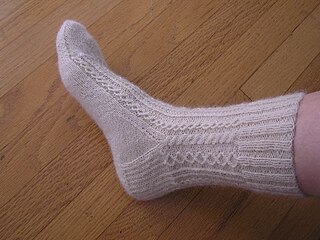
A shoe is an item of footwear intended to protect and comfort the human foot. Though the human foot can adapt to varied terrains and climate conditions, it is vulnerable, and shoes provide protection. Form was originally tied to function but over time shoes also became fashion items. Some shoes are worn as safety equipment, such as steel-toe boots, which are required footwear at industrial worksites.

Footwear refers to garments worn on the feet, which typically serve the purpose of protection against adversities of the environment such as wear from rough ground; stability on slippery ground; and temperature.

A boot is a type of footwear. Most boots mainly cover the foot and the ankle, while some also cover some part of the lower calf. Some boots extend up the leg, sometimes as far as the knee or even the hip. Most boots have a heel that is clearly distinguishable from the rest of the sole, even if the two are made of one piece. Traditionally made of leather or rubber, modern boots are made from a variety of materials.

Clogs are a type of footwear made in part or completely from wood. Used in many parts of the world, their forms can vary by culture, but often remained unchanged for centuries within a culture.

Flip-flops are a type of light sandal-like shoe, typically worn as a form of casual footwear. They consist of a flat sole held loosely on the foot by a Y-shaped strap known as a toe thong that passes between the first and second toes and around both sides of the foot. This style of footwear has been worn by people of many cultures throughout the world, originating as early as the ancient Egyptians in 1,500 B.C. In the United States the modern flip-flop may have had its design taken from the traditional Japanese zōri, after World War II as soldiers brought them back from Japan.

Geta (下駄) are traditional Japanese footwear resembling flip-flops. A kind of sandal, geta have a flat wooden base elevated with up to three "teeth", held on the foot with a fabric thong, which keeps the foot raised above the ground.

Waraji are light tie-on sandals, made from ropemaking fibers, that were the standard footwear of the common people in Japan.

Sandals are an open type of shoe, consisting of a sole held to the wearer's foot by straps going over the instep and around the ankle. Sandals can also have a heel. While the distinction between sandals and other types of footwear can sometimes be blurry, the common understanding is that a sandal leaves all or most of the foot exposed. People may choose to wear sandals for several reasons, among them comfort in warm weather, economy, and as a fashion choice. Usually, people wear sandals in warmer climates or during warmer parts of the year in order to keep their feet cool and dry. The risk of developing athlete's foot is lower than with enclosed shoes, and the wearing of sandals may be part of the treatment regimen for such an infection.

Athlete's foot, known medically as tinea pedis, is a common skin infection of the feet caused by a fungus. Signs and symptoms often include itching, scaling, cracking and redness. In rare cases the skin may blister. Athlete's foot fungus may infect any part of the foot, but most often grows between the toes. The next most common area is the bottom of the foot. The same fungus may also affect the nails or the hands. It is a member of the group of diseases known as tinea.

Opanci are traditional peasant shoes worn in Southeastern Europe. The attributes of the opanci are a construction of leather, lack of laces, durable, and various endings on toes. In Serbia, the design of the horn-like ending on toes indicates the region of origin, though this specific design is not exclusive to Serbia. The opanci are also considered as the traditional peasant footwear for people in the Balkan region. In Bulgaria they are referred to as "tsarvuli".

Hiking (walking) boots are footwear specifically designed for protecting the feet and ankles during outdoor walking activities such as hiking. They are one of the most important items of hiking gear, since their quality and durability can determine a hiker's ability to walk long distances without injury. Hiking boots are constructed to provide comfort for walking considerable distance over rough terrain. Boots that protect the hiker's feet and heel are recommended. Hiking boots give ankle support and are fairly stiff. A less popular alternative is to use light trainers with thin soles. Footwear should be neither too loose nor too tight, to help prevent blisters and sore feet. Hiking socks that wick sweat from the feet, provide warmth, and cushion the feet are recommended and a thin, inner sock may also help. Most hiking boots are also designed for other outdoor activities such as backpacking, climbing, mountaineering, and hunting.

Mukluks or kamik are soft boots, traditionally made of reindeer (caribou) skin or sealskin, and worn by Arctic aboriginal people, including the Inuit, Iñupiat, and Yup'ik.

Sportswear or activewear is clothing, including footwear, worn for sport or physical exercise. Sport-specific clothing is worn for most sports and physical exercise, for practical, comfort or safety reasons.

Sailing wear is a type of clothing for sailing. It protects the sailor from water and insulates the body on board a vessel.

Pitted keratolysis is a bacterial skin infection of the foot. The infection is characterized by craterlike pits on the sole of the feet and toes, particularly weight bearing areas.

Forensic footwear evidence can be used in legal proceedings to help prove that a shoe was at a crime scene. Footwear evidence is often the most abundant form of evidence at a crime scene and in some cases can prove to be as specific as a fingerprint. Initially investigators will look to identify the make and model of the shoe or trainer which made an impression. This can be done visually or by comparison with evidence in a database; both methods focus heavily on pattern recognition and brand or logo marks. Information about the footwear can be gained from the analysis of wear patterns which are dependent on angle of footfall and weight distribution. Detailed examination of footwear impressions can help to link a specific piece of footwear to a footwear imprint as each shoe will have unique characteristics.

Clothing fetishism or garment fetishism is a sexual fetish that revolves around a fixation upon a particular article or type of clothing, a particular fashion or uniform, or a person dressed in such a style.

A sock is a piece of clothing worn on the feet and often covering the ankle or some part of the calf. Some types of shoes or boots are typically worn over socks. In ancient times, socks were made from leather or matted animal hair. In the late 16th century, machine-knit socks were first produced. Until the 1800s, both hand-made and machine-knit socks were manufactured, with the latter technique becoming more common in the 19th century, and continuing until the modern day.

Boat shoes are typically canvas or leather with non-marking rubber soles designed for use on a boat. A siping pattern is cut into the soles to provide grip on a wet deck; the leather construction, along with the application of oil, is designed to repel water; and the stitching is highly durable. Boat shoes are traditionally worn without socks.

The Vibram FiveFingers are a type of minimalist shoe manufactured by Vibram, originally marketed as a more natural alternative for outdoor activities. The footwear is meant to replicate being barefoot and has thin, flexible soles that are contoured to the shape of the human foot, including visible individual sections for the toes. The company settled a lawsuit in 2014 alleging false health claims and set aside $3.75 million to pay refunds of up to $94 to anyone who had purchased the product since March 21, 2009.




















